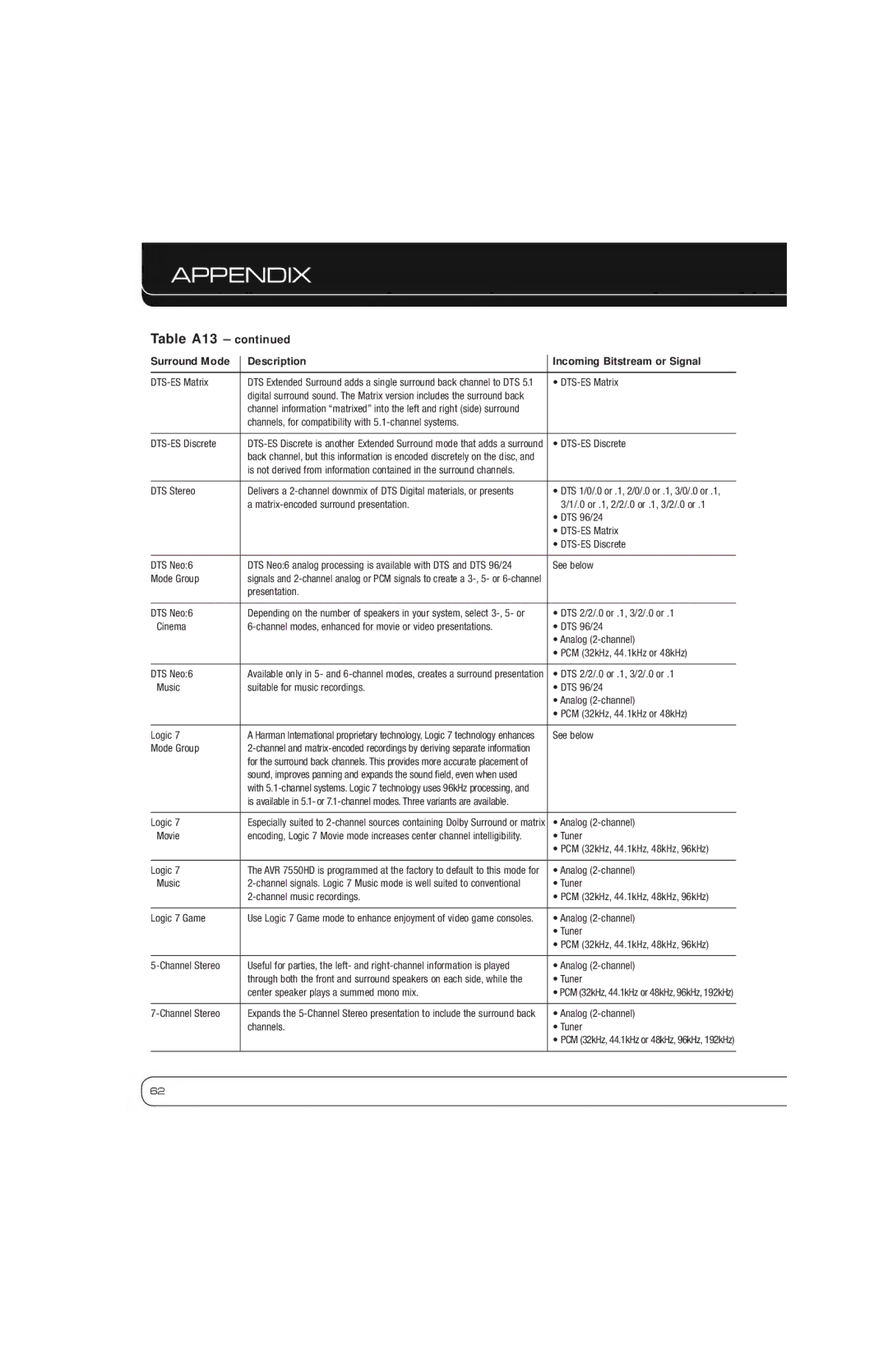
APPENDIX
Table A13 – continued
Surround Mode | Description | Incoming Bitstream or Signal |
|
|
|
| DTS Extended Surround adds a single surround back channel to DTS 5.1 | • |
| digital surround sound. The Matrix version includes the surround back |
|
| channel information “matrixed” into the left and right (side) surround |
|
| channels, for compatibility with |
|
|
|
|
• | ||
| back channel, but this information is encoded discretely on the disc, and |
|
| is not derived from information contained in the surround channels. |
|
|
|
|
DTS Stereo | Delivers a | • DTS 1/0/.0 or .1, 2/0/.0 or .1, 3/0/.0 or .1, |
| a | 3/1/.0 or .1, 2/2/.0 or .1, 3/2/.0 or .1 |
|
| • DTS 96/24 |
|
| • |
|
| • |
|
|
|
DTS Neo:6 | DTS Neo:6 analog processing is available with DTS and DTS 96/24 | See below |
Mode Group | signals and |
|
| presentation. |
|
|
|
|
DTS Neo:6 | Depending on the number of speakers in your system, select | • DTS 2/2/.0 or .1, 3/2/.0 or .1 |
Cinema | • DTS 96/24 | |
|
| • Analog |
|
| • PCM (32kHz, 44.1kHz or 48kHz) |
|
|
|
DTS Neo:6 | Available only in 5- and | • DTS 2/2/.0 or .1, 3/2/.0 or .1 |
Music | suitable for music recordings. | • DTS 96/24 |
|
| • Analog |
|
| • PCM (32kHz, 44.1kHz or 48kHz) |
|
|
|
Logic 7 | A Harman International proprietary technology, Logic 7 technology enhances | See below |
Mode Group |
| |
| for the surround back channels. This provides more accurate placement of |
|
| sound, improves panning and expands the sound field, even when used |
|
| with |
|
| is available in |
|
|
|
|
Logic 7 | Especially suited to | • Analog |
Movie | encoding, Logic 7 Movie mode increases center channel intelligibility. | • Tuner |
|
| • PCM (32kHz, 44.1kHz, 48kHz, 96kHz) |
|
|
|
Logic 7 | The AVR 7550HD is programmed at the factory to default to this mode for | • Analog |
Music | • Tuner | |
|
| • PCM (32kHz, 44.1kHz, 48kHz, 96kHz) |
|
|
|
Logic 7 Game | Use Logic 7 Game mode to enhance enjoyment of video game consoles. | • Analog |
|
| • Tuner |
|
| • PCM (32kHz, 44.1kHz, 48kHz, 96kHz) |
|
|
|
| Useful for parties, the left- and | • Analog |
| through both the front and surround speakers on each side, while the | • Tuner |
| center speaker plays a summed mono mix. | • PCM (32kHz, 44.1kHz or 48kHz, 96kHz, 192kHz) |
|
|
|
Expands the | • Analog | |
| channels. | • Tuner |
|
| • PCM (32kHz, 44.1kHz or 48kHz, 96kHz, 192kHz) |
|
|
|
62
